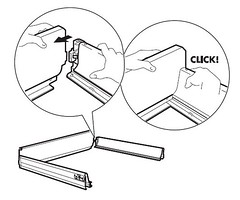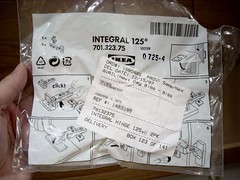One reason the cabinets are cheap is because we bought them at IKEA, which means I had to spend a couple of weekends assembling the cabinet shells. Because IKEA is a multinational company, the instruction booklets that come with them are printed with a numbered series of illustrations that are intended to show you how to assemble the components. But there are no words, because they'd need to have them in 40 languages and the books would be 100 pages long. So it's all done with manipulation drawings:

These instructions are sometimes simple and obvious, and other times force you to sit in a cramped position on the living room floor turning the pieces over in your hands and studying the illustrations until a vein in your forehead bursts.
However, there is one word that is used occasionally: "Click." I have to assume that this one word is universally translatable into Swahili, Farsi, Mandarin, Inuit, etc.

The problem is, things never quite "click" the first time. You mess with it and mess with it, and then you either figure out what you're doing wrong, or you drive 50 miles round trip to IKEA to exchange it for one that does click, or you throw it against the wall, where it makes a far more satisfying "THUNK" sound. To be fair, some of the things we've purchased come in large numbers (such as cabinet hinges). Once you figure out how to make them click properly, it's usually not hard to get the rest to click as well.
In my efforts to complete these cabinets, I've discovered two major design issues. The first design problem is that the cabinet shells have three different-sized holes drilled partway through them. The largest is for cams (used to tighten components together), the middle size is for wooden pegs (used to hold components together), and the smallest is for screws to attach brackets or shelf supports. The problem is that the middle-sized hole is exactly the size of the screw head used in the smallest hole.

If you fumble while screwing (and who hasn't?), you may drop a screw in such a way that it falls into one of the middle-sized holes, as I did. If the middle-sized peg holes were just a tiny bit smaller, the screw wouldn't fit. If they were a tiny bit larger, you could just shake the screw out.
There is no way to extract the screw, because they're non-magnetic. I tried digging it out, pounding on the cabinet from the other side, even bending over and sucking on the hole. Nothing worked. And of course, I couldn't just leave it there, because IKEA only gives you exactly the number of screws you need to complete the assembly. I was forced to drill a hole in the other side of the cabinet, to push the screw out from the other side.
The second design problem is that IKEA is always trying to save money, to ensure that their cabinets are cheap enough to satisfy the female equation. So the assembly instructions for cabinet hinges are printed on the package, rather than on a booklet contained in the package. This is a great idea for saving paper, but then some moron in the shipping department pastes the order label on the package, obscuring the instructions. The label is attached with some kind of industrial adhesive and cannot be removed without destroying the package.

It took me an hour of fumbling and cursing and holding the package up to the light to finally decipher the assembly procedure.

2 comments:
huh - huh....you said "bending over and sucking on the hole."
sometimes i can't resist. after all you know who i had to work with for three plus years!
you are right about the instructions but sometimes even the workmanship is lacking. I just helped a friend put together a living room, and dining room set and the coffee table seemed to be the easiest to put together....it seemed. once we got it out of the box, it had a marble top inlay so it was very heavy, but there were only 5 parts..the top itself and 4 legs with 2 heavy 4" bolts per leg, so easy instructions were not need, nor were provided. And for the most part, it was easy except for one thing.... on the last leg, the 2 holes that are pre-drilled in the table to connect the last leg were NOT drilled! So we just left the table with 3 attached legs and one proped under one corner....an accident just waiting to happen.
Post a Comment